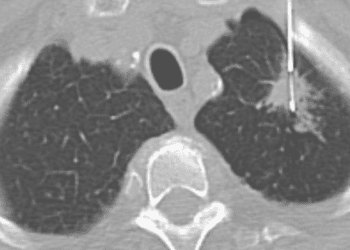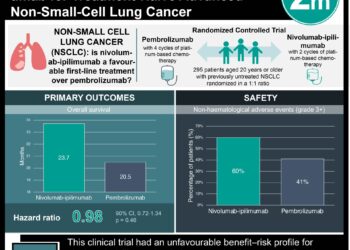High tumour mutation burden in NSCLC associated with improved clinical outcomes of PD-L1 blockade across PD-L1 expression subgroups
1. High tumour mutation burden levels were associated with improvements in objective response rate, progression-free survival, and overall survival, with patients with PD-L1 expression of 50% or higher experiencing the most benefit.
2. A high tumour mutation burden was associated with immune cell infiltration and inflammatory T-cell response, which led to increased sensitivity to PD-L1 inhibition across PD-L1 subgroups.
Evidence Rating Level: 2 (Good)
Study Rundown: There is a need for identifying biomarkers of immune checkpoint inhibitor (ICI) response in non-small cell lung cancer (NSCLC). While tumour mutation burden (TMB) has recently emerged as a potential biomarker, the optimal TMB threshold needed to discriminate responders from non-responders remains unclear. This study analyzed multiple independent cohorts of patients with NSCLC treated with PD-L1 inhibitors in order to determine the correlation between increasing TMB levels and the efficacy of immunotherapy across different subgroups of PD-L1 expressions in NSCLC patients. The three cohorts were taken from three different institutions, and in each cohort, tumours that responded to immunotherapy had significantly higher TMB than patients with stable or progressive disease. A higher TMB in each cohort was also associated with significant improvements in objective response rate (ORR), progression-free survival (PFS), overall survival (OS), immune cell infiltration and inflammatory T-cell response. ORR and survival benefits were found in each clinically relevant PD-L1 expression subgroup (<1%, 1% to 49%, and >50%), with the biggest improvement in the PD-L1 expression of >50% group. Data from all three platforms were normalized to produce a harmonized TMB score, and a preliminary optimal TMB threshold was found. The strength of this study is that its data allows for further stratification of immunotherapy outcomes for patients within clinically relevant PD-L1 expression groups. Chemotherapy could therefore potentially be avoided in cancers with PD-L1 expression and high TMB expression. Limitations to this study include its retrospective design with no comparison group, as well as a lack of PD-L1 expression data for some of the patients. Overall, this study suggests that TMB may be an independent data point to help further stratify sensitivity to PD-L1 inhibition across PD-L1 expression subgroups.
Click to read the study in JAMA Oncology
Relevant Reading: TMB in NSCLC: a broken dream?
In-Depth [retrospective cohort]: This multicenter retrospective cohort study analyzed 1552 patients with advanced NSCLC that were treated with PD-L1 inhibitors. Cohorts were taken from the Dana-Farber Cancer Institute (DFCI) [714 patients], the Memorial Sloan Kettering Cancer Center (MSKCC) [672 patients], and the Stand Up to Cancer (SU2C) Foundation [166 patients]. A high harmonized TMB z score was found to be 1.16 or higher, which corresponded to >19.0 mutations per megabase for the MSKCC cohort, >19.3 for the DFCI cohort, and >16.0 for the SU2C Foundation cohort. The high harmonized TMB score had significantly improved clinical outcomes than the low harmonized TMB scores: ORR (49.1% vs 21.5%; difference, 27.6%; 95% confidence interval [CI], 19.6% to 35.6%), PFS (11.4 months vs 2.8 months; hazard ratio [HR], 0.40; 95% CI, 0.33 to 0.50; P>0.001), OS (36.1 months vs 12.4 months; HR, 0.46; 95% CI, 0.37 to 0.59; P<0.001). ORR and survival benefits were found in each clinically relevant PD-L1 expression subgroup, with patients with both high TMB and PD-L1 expression of >50% having the highest ORR, and longest PFS and OS (57%, 18.1 months, 47.7 months, respectively). By contrast, patients with low-TMB and PD-L1 negative expression had the lowest ORR, and shortest PFS and OS (8.7%, 2.1 months, 10.4 months, respectively). The results of this study indicated that a TMB threshold close to the 90th percentile may be the optimal threshold to discern responders from non-responders. Overall, a high TMB is associated with increased immunotherapy sensitivity and improved clinical outcomes across all PD-L1 expression patients with NSCLC.
Image: PD
©2022 2 Minute Medicine, Inc. All rights reserved. No works may be reproduced without expressed written consent from 2 Minute Medicine, Inc. Inquire about licensing here. No article should be construed as medical advice and is not intended as such by the authors or by 2 Minute Medicine, Inc.





![ABCD2 Score: Predicting Early Stroke Risk After Transient Ischemic Attack (TIA) [Classics Series]](https://www.2minutemedicine.com/wp-content/uploads/2013/05/web-cover-classics-with-logo-medicine-BW-small-jpg-75x75.jpg)


